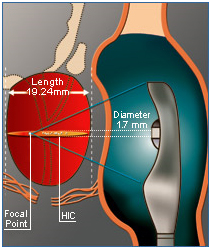Prostate Cancer Treatments

There are numerous treatments for localized prostate cancer and each has its own benefits and drawbacks. Patients and their physicians must weigh many factors when determining the best treatment option. Age, Gleason score (measures aggressiveness), PSA, lifestyle and quality of life all may be factors in the equation of finding the optimal treatment.
Treatments available include : -
- High Intensity Focused Ultrasound (HIFU)
- Radical prostatectomy
- Radiation therapy
- Hormone therapy
- Cryotherapy
Some patients are choosing no treatment at all, called watchful waiting or active surveillance, because of the effects on quality of life after treatment. The treatment modalities are described below in more detail.
IMPORTANT INFORMATION : HIFU with the Sonablate® 500 is not approved for use in the U.S. The Sonablate® 500 remains investigational in the U.S. and is being studied for the treatment of prostate cancer in clinical trials in the U.S. FDA has made no decision as to the safety or efficacy of the Sonablate® 500 for the treatment of prostate cancer. The information below is provided for general information purposes only and is not intended to replace sound professional medical advice and care. All treatment options and potential outcomes and complications should be discussed with a qualified health care provider.
High Intensity Focused Ultrasound
HIFU with the Sonablate 500 is a minimally invasive treatment option for prostate cancer that uses a transrectal probe to focus ultrasound waves in the prostate. At a very precise and targeted location, the temperature is rapidly elevated which causes tissue destruction. During HIFU, typically the entire prostate is treated or ablated. In most cases, HIFU with the Sonablate 500 takes between two to four hours and is performed as an out-patient procedure. A catheter is inserted during the procedure that is worn for one to four weeks. People usually are up and walking around within hours after HIFU and can return to a normal lifestyle within a couple of days. After the procedure, some HIFU patients experience frequency, urgency, mild discomfort or discharge in urinary stream. Studies performed outside the US report that potential side effects may also include urinary stricture, retention, incontinence, erectile dysfunction and rectal fistula.
Radical Prostatectomy
A radical prostatectomy is surgery to remove the entire prostate gland and some of the tissue around it and may be done by open or laparoscopic surgery. The advantages of a radical prostatectomy include complete removal of the prostate and a long history of use. An open prostatectomy may take two to four hours, and a laparoscopic prostatectomy may take up to eight hours. The procedure is usually performed under general anesthesia and requires a hospital stay and catherization.
Radiation Therapy
There are two primary types of radiation therapy: External Beam Radiation Therapy (“EBRT”) and brachytherapy or seed implants. EBRT is usually recommended for men with a prostate volume less than 60 grams and involves several weeks of radiation directed at the cancer from outside of the body. Brachytherapy is radiation therapy transmitted by tiny radioactive pellets placed inside the prostate.
Hormone Therapy
Hormone therapy, also known as androgen deprivation therapy or androgen suppression therapy aims to reduce the levels of male hormones, such as testosterone, in the body. Lowering these hormone levels can shrink prostate cancer tumors or slow the growth. However, hormone therapy is a palliative treatment and does not cure prostate cancer, and carries a risk of side effects such as decreased mental acuity, fatigue, weight gain, depression, anemia, osteoporosis, anemia and loss of muscle mass.
Cryotherapy
Cryotherapy, also known as cryosurgery or cryoablation, is a minimally invasive procedure that involves freezing the cells in the prostate to bring about destruction or elimination. Cold gases are passed through needles that are placed in the prostate, creating ice balls that destroy the gland. The procedure is ultrasound guided by a physician and is usually performed under spinal, epidural, or general anesthesia. Side effects from cryotherapy may include swelling, erectile dysfunction, incontinence and rectal fistula.
Again, the information is provided for general information purposes only and is not intended to replace sound professional medical advice and care. All treatment options, potential outcomes and complications should be discussed with a qualified health care provider.
List of HIFU Treatment's as follows : -
|
 |
 |
|
|
|
India Prostate Cancer Treatment Cost,Hifu Treatment Prostate Cancer Therapy Replace Conventional Surgery, High Intensity, Hifu, High Intensity Focused Ultrasound, Hifu Specialist, Hifu Prostate Cancer, Hifu Treatment Prostate Cancer, High Intensity Focused Ultrasound Hospitals, India High Intensity Focused Ultrasound Surgeon, India High Intensity Focused Ultrasound Surgery Center, India Prostate Cancer Treatment, Cryocare, High Intensity Focused Ultrasound Bangalore, India Brachytherapy, Hifu Treatment Prostate Cancer, High Intensity Focused Ultrasound Mumbai, India Radiation, Proton, Hifu Treatment Prostate Cancer Mumbai, India Vaporization, Radical, Prostatectomy, Nerve, Sparing ,Robotic Laparoscopic, Hypertrophy, Davinci Robot, High Intensity Focused Ultrasound Clinic, India Cancer, Treatment, Hifu, High, Intensity, Focused, Ultrasound, Therapy, Noninvasive, Surgery, Cryotherapy, Hifu Treatment Prostate Cancer Bangalore, India Intuitive, Surgical, Enlarged Prostate, Focus, Ablatherm, Male, Lumpectomy



